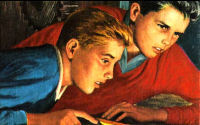

History of the Hardy Boys digests
In 1979, the Stratemeyer Syndicate took its business to a new publisher: Simon & Schuster, whose Hardy Boys volumes picked up where Grosset & Dunlap left off. The Hardy Boys Mystery Stories, from volume 59 on, are commonly referred to as the Hardy Boys "digests".
Simon & Schuster agressively promoted and modernized the books. Here are some of the changes in format:
- A new cover design features "The Hardy Boys" at the top, the cover art in an arch-like border, and the book title at the bottom. The cover art no longer occupies the entire cover.
- The books are also released in paperback; in fact, paperbacks are much more common than hardcovers.
- Instead of a series checklist, the back cover now contains a plot summary/teaser.
- Credit is given to the cover illustrator and designer, as well as the interior illustrator.
- Interior illustrations are sometimes greyscale, rather than black-and-white line drawings.
- There's no longer a frontispiece illustration.
- The copyright page contains a lot more information.
- The series is consistently referred to as "The Hardy Boys Mystery Stories."
Despite these changes, the books are similar in plot and style to the later Grosset & Dunlap editions.
Simon & Schuster broke with Grosset & Dunlap's longstanding one-book-per-year tradition. For the most part, a new volume was released every other month. Initially, the books were published by Simon & Schuster's Wanderer Books imprint, but they were later switched to the Minstrel Books imprint, and finally to the Aladdin imprint.
Cover formats
The cover format has been revamped several times. In this author's opinion, the most effective covers were those that used the checkerboard border format of the late 1980s and 1990s, such as volume 105. Recent designs tend to be very trendy, and in the final layout, Frank and Joe don't even appear in the illustration.
 #65, 1981 |
 #83, 1985 |
 #105, 1990 |
 #140, 1996 |
 #174, 2002 |
Notice that the covers of volume 105 and 140 proclaim "All-new! First time published!", as the publisher attempts to convince prospective readers that "this is not your father's Hardy Boys book!"
